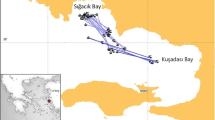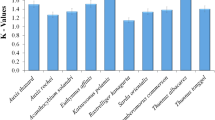Abstract
The Length-weight relationship is a commonly used tool for fishery data analysis especially for fish population stock assessment study to support developing fisheries management policy and sustainable fishery. Flying fishes are considered as commercially and ecologically important species across the globe. The Length-weight relationships of flying fish is very rare and even limited to the Bay of Bengal. Length-weight relationship parameters were analysed for four flying fish species from the Southeast coast of India, Bay of Bengal. The samples were collected from March 2020 to January 2021 from different landing centres such as Tuticorin, Mandapam and Chennai along the Southeast coast of India by drift gill net, and commercial trawls. Samples were captured in the depth range between 30 and 200 m. Values of the parameter b ranged from 2.852 for Cheilopogon abei to 3.1263 for Cheilopogon suttoni indicating the allometric growth. The present study provides length-weight relationship of species Cheilopogon abei, Cheilopogon furcatus, Cheilopogon cyanopterus and Cheilopogon suttoni for the first time.
Similar content being viewed by others
Avoid common mistakes on your manuscript.
Introduction
The Length-weight relationship is a commonly used tool for fishery data analysis especially for fish population stock assessment study to support developing fisheries management policy and sustainable fishery (Froese 2006). The Length-weight relationship differ among the fish species depending on the inherited body shape and within the species based on the type of ecological characters, environmental parameters and biological factors (Eduardo et al. 2018; Kannan et al. 2021), especially on gonadal development, feeding rate, maturity condition and might change over seasons or even days (Beyer 1987; De Giosa et al. 2014). The flying fishes are epipelagic group which spread with oceanic and inshore waters particularly in tropical and subtropical waters around the globe. They are regarded as ecologically and commercially important species. They are an important fishery resource in Indonesia, Japan, Korea, China, West Africa (Gibbs 1978), USA and South India (BOBLME 2015; Shakhovskoy 2018). Apart as food, it is usually used as bait to capture larger predatory fish species which are of high commercial value and their eggs are used for the production of local caviar. Besides their commercial importance, the flying fishes are crucial components in the epipelagic food chain. The Length-weight relationships of flying fish group of the family Exocoetidae is very rare and even limited to the Bay of Bengal (Rao and Basheeruddin 1973; Vinoth and Ramachandra Prabu 2014; Mahadevan et al. 2020). The present study provides length-weight parameters for flying fishes from Bay of Bengal. This information will enhance management and conservation to allow future comparisons between populations of the same species in future.
Materials and Methods
The study was carried out along the Southeast coast of India. Fish samples were acquired from March-2020 to January-2021 from the landing centres of Tuticorin, Mandapam and Chennai from Bay of Bengal by using trawlers (cod-end mesh size of 35 mm at the depth of 60–80 m) and drift gill net (120–140 mm mesh size, 50 m length, 6–8 m breadth). The collected fish specimens were sorted, washed and ice-packed and transported to the laboratory for further biometric analysis. Fish species were confirmed by standard identification key and updated scientific names were referred (Fischer and Bianchi 1984; Froese and Pauly 2020). Total length and weight were measured with an accuracy of 0.1 cm and 0.01 g respectively. The LWR was determined by using the equation TW = a TLb where TW is total weight, TL is the total length (cm) and parameter of ‘a’ indicates the intercept ‘b’ indicates the slope of the relationship i.e., the coefficient of allometry. About 95% confidence limit of ‘a’ and ‘b’ and coefficient of determination (r2) were also determined. Outliers were identified in the log-log plots and excluded before the regression analysis (Froese 2006).
Results
A total of 547 specimens comprising four species belonging to Exocoetidae family were caught from Southeast coast of India. The estimated parameters of LWR including sample size (n), Total length and weight range, 95% confidence limit of ‘a’ and ‘b’, determination coefficient (r2) were given in Table 1. The coefficient of allometry (b) for four species of flying fishes obtained from this study were well fit within the expected range of 2.5–3.5 (Froese 2006) which was influenced by fishing habitat; gear selection and mesh size; craft operation, seasonal variation of fishery, sex, maturity stages, feeding habitat, size range of specimens (Matos et al. 2019; Kannan et al. 2020a, 2020b; Kannan et al. 2021). The coefficient of determination (r2) values were greater than 0.95, it is range from Cheilopogon suttoni (0.960) to Cheilopogon abei (0.986) which might be due to observation of the species with narrow size range of specimens that influence the changes in r2 values.
Discussion
The flying-fish is an important seasonal fishery on the East coast of India. These flying-fish fishery is commercially important for local consumption of fresh as well as dry fish. Flying fish is a low-fat high-protein species that yield approximately 35–50% of edible flesh. It is an excellent source of essential amino acids, and docosahexaenoic acid. The fishing season of these flying fishes commences three months during May to July from Chennai to Coromandel coasts. The gill net with mesh size of 31 mm and 41 mm were used for exploiting small and large sized flying fishes respectively. In the traditional method, scoop net and a drifting type of fish aggregating device are used for the exploitation of flying fishes along Tamil Nadu coast. There is no previous studies are available on the population status assessment of flying fish species in the Bay of Bengal but it seems the population of flying fish is declining. The present study provides the baseline information of these flying fish species which would help in the future for biological comparison as well as useful for by ecological and economic significance from Bay of Bengal. More studies are needed because many species in the Exocoetidae family lack information about taxonomy, population parameters to support the development of sustainable fisheries management in this ecosystem. Further detailed taxonomical confirmation of flying fish species may helpful for to understand the species specific fisher assessment in these region and intensive sampling of this species could help for researcher, scientists and fishery biologist to prepare a management plan for sustainable fishing of flying fishes in the East cost of India, Bay of Bengal.
Data Availability
The data that support the findings of this study are available from the corresponding author upon request.
References
Beyer JE (1987) On length-weight relationship. Part I: Computing the mean weight of the fish of a given length class. Fishbyte 5(1):11–13
BOBLME (2015) An ecosystem characterisation of the Bay of Bengal. Compiled by Brewer D, Hayes D, Lyne V, Donovan A, Skewes T, Milton D, Murphy N. BOBLME-2015-Ecology-13. 287p
De Giosa M, Czerniejewski P, Rybczyk A (2014) Seasonal changes in condition factor and weight-length relationship of invasive Carassius gibelio (Bloch, 1782) from Leszczynskie Lakeland, Poland. Adv Zool 2014:678763. https://doi.org/10.1155/2014/678763
Eduardo LN, Frédou T, Lira AS, Silva LVS, Ferreira BP, Bertrand A, Ménard F, Frédou FL (2018) Length–weight relationship of thirteen demersal fishes from the tropical brazilian continental shelf. J Appl Ichthyol 35(2):590–593. https://doi.org/10.1111/jai.13831
Fischer W, Bianchi G (1984) FAO species identification sheets for fishery purposes. Western Indian Ocean; (fishing area 51). Prepared and printed with the support of the danish International Development Agency (DANIDA). FAO of the United Nations, Rome, Italy
Froese R (2006) Cube law, condition factor, and weight-length relationships: history, meta analysis and recommendations. J Appl Ichthyol 22(4):241–253. https://doi.org/10.1111/j.1439-0426.2006.00805.x
Froese R, Pauly D (eds) (eds) (2020) FishBase. World Wide Web electronic publication, version (1/2019). Retrieved from http://www.fishbase.org
Gibbs RH Jr (1978) Exocoetidae, flyingfishes. In: Fisher, W. (ed.) FAO species identification sheets for fishery purposes. Western Central Atlantic (fishing area 31), Vol. 2, pag. var. FAO, Rome
Kannan K, Kannapiran E, Kodeeswaran P, Kumar R, Madhuri K, Divya D (2020a) Length-weight relationships of three Clupeiformes species from the Southeast coast of India, Bay of Bengal, Eastern Indian Ocean. J Appl Ichthyol 36(6):860–862. https://doi.org/10.1111/jai.14092
Kannan K, Kodeeswaran P, Kumar R, Madhuri K, Divya D, Kannapiran E (2020b) Length-weight relationship of Coral reef-associated fishes from Gulf of Mannar and Palk Bay, Southeast Coast of India. J Appl Ichthyol 37(1):162–164. https://doi.org/10.1111/jai.14102
Kannan K, Sivaranjani S, Kumar R, Karuppasamy K, Prabhu NM, Kannapiran E (2021) Length-weight relationship of six demersal fish species from Gulf of Mannar, Bay of Bengal, Eastern Indian Ocean. J Appl Ichthyol 37(2):367–369. https://doi.org/10.1111/jai.14177
Mahadevan G, Gosavi SM, Murugesan P (2020) Length-weight Relationships and Condition factor of five Marine Finfish Species from Parangipettai (Tamil Nadu) and Mumbai (Maharashtra) Coast of India. Thalassas 36:375–385. https://doi.org/10.1007/s41208-020-00222-y
Matos OF, Pereira DV, Aguiar-Santos J, Sampaio AS, Carvalho Freitas CE, Siqueira-Souza FK (2019) Length-weight relationships of five fish species from lakes of the central amazonian floodplains. J Appl Ichthyol 35(3):799–801. https://doi.org/10.1111/jai.13901
Mitchill SL (1815) The fishes of New York described and arranged, vol. 1. Transactions of the Literary and Philosophical Society of New York, pp 355–492
Parin NV (1996) On the species composition of flying fishes (Exocoetidae) in the West-Central part of tropical Pacific. J Ichthyol 36(5):357–364
Rao KS, Basheeruddin S (1973) Unusual catches of flyingfish, Parexocoetus brachypterus (Richardson) in inshore waters at Madras. Indian J Fish 20:629–634
Shakhovskoy IB (2018) Distribution of flying fishes of the genera Exocoetus, Hirundichthys and Cypselurus. FishTaxa 3(4):40–80
Vinoth A, Ramachandra Prabu S (2014) Length weight relationship and condition factor of Hirundichthys coromandelensis (flying fish) in Bay of Bengal near Pulicat coas. Int J Inf Res Rev 1(11):162–164
Acknowledgements
The authors (K.K. and S.R.) would like to thank the Management and Department of Zoology, Kongunadu Arts and Science College, Coimbatore for valuable support.
Author information
Authors and Affiliations
Contributions
K.K. collected and analyzed the samples; K.R. edited the manuscript; R.S. helped in collecting the samples; K.C.P. assisted in analysing the samples; E.K. supervised the work. All authors reviewed the manuscript.
Corresponding author
Ethics declarations
Conflict of Interest
Authors declare that they do not have any conflict of interest.
Additional information
Publisher’s Note
Springer Nature remains neutral with regard to jurisdictional claims in published maps and institutional affiliations.
Rights and permissions
Springer Nature or its licensor (e.g. a society or other partner) holds exclusive rights to this article under a publishing agreement with the author(s) or other rightsholder(s); author self-archiving of the accepted manuscript version of this article is solely governed by the terms of such publishing agreement and applicable law.
About this article
Cite this article
Karuppiah, K., Rajendran, K., Selvaraju, R. et al. Length-weight relationship of flying fishes (Exocoetidae) from Bay of Bengal, Eastern Indian Ocean. Thalassas 39, 509–512 (2023). https://doi.org/10.1007/s41208-023-00549-2
Received:
Revised:
Accepted:
Published:
Issue Date:
DOI: https://doi.org/10.1007/s41208-023-00549-2




